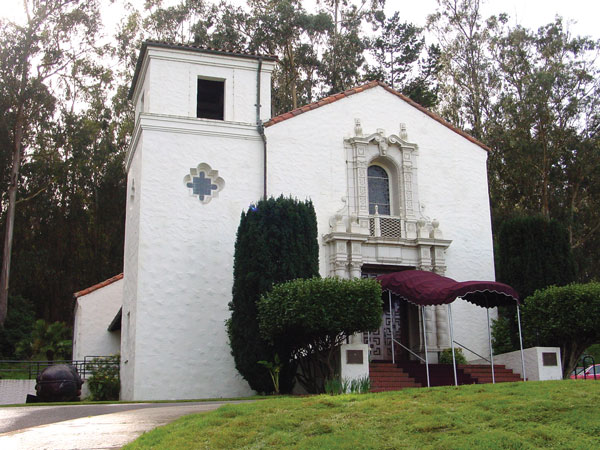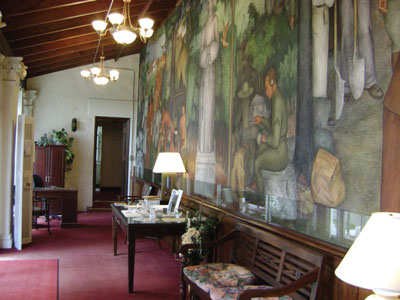Features
A Gem In The Forest: Presidio Chapel Houses Faith, Art And History
November 2011
A Gem In The Forest: Presidio Chapel Houses Faith, Art And History
November 2011

The Presidio Chapel sits on a knoll just off the Main Post
Photo: Presidio Trust
There will be no peace among nations unless there is peace among religions. And there will be no peace among religions unless there is authentic dialogue among religions.
– Hans Kung, Catholic theologian
In an age when religions the world over are literally at war with each other, there is a gem in the Presidio that houses a little-known program perpetuating the words and concepts of Hans Kung.
Located in the Presidio Chapel, the Interfaith Center has worked with multiple interfaith agencies in the Bay Area since 1996, two years after the United States Army turned the Presidio over to the National Park Service. Its mission is to bring people of many religions together to foster understanding and peace among the peoples of the world.
A tall order? Certainly. But religion has been a guiding principle ever since the Spanish built the first Presidio chapel on the Ohlone Indian tribe’s sacred space in 1776. When the Mexican government claimed the land, it too created a chapel, and finally in 1864, after the land became American property, the United States 6th Army built its own chapel. The Spanish and Mexican chapels were Catholic with a priest leading the services. The American chapel welcomed the Christian, Jewish and Muslim families who were represented in the U.S. Army. In 1931 during the Depression, Congress gave the Army $39,000 to build the current-day Presidio Chapel. The charming building, sitting on a forested hillside overlooking the San Francisco Bay, is flanked by the veterans’ cemetery and a colorful garden. The sanctuary seats 175 and displays no religious symbol other than an eternal light. Plaques honoring fallen military Americans adorn the walls.
“The U.S. Army personnel were smart enough to know that there were families of different faiths stationed at the Presidio and they needed a chapel to serve everyone,” said Rita Semel, a founder of the San Francisco Interfaith Center.
Presidio Interfaith Center
In 1992, Bay Area religious leaders began talking about bringing together people of different faiths who would share ideas and learn from each other. The Presidio Chapel became home to this group and in 1995, the Interfaith Center of the Presidio was born.
There is no permanent chaplain at the chapel but the Interfaith Center does have a board of directors. “Between 15 and 20 religions have been represented on the board over the years,” said Linda Crawford, campaign and project director. Among the Center’s extensive affiliations are the North American Interfaith Network, the Parliament of the World’s Religions, and the United Religions Initiative.
Celebrations, guest lectures, conferences, and workshops take place throughout the year at the Interfaith Center, which is also popular for interfaith weddings.
Rita Semel recalls escorting six Jordanians who were invited to observe the Center by the U.S. State Department.
“I took them around and talked to them about our freedoms. They were blown out of the water. They had no provision for freedom of religion,” she said. “When we talked about how freedom of religion as well as freedom of speech and the right to assembly is part of our constitution, they were amazed. They haven’t experienced these kinds of rights in their home countries.”
The Interfaith Center at the Presidio and all of its affiliate organizations represent a microcosm of a larger goal, where all religions respect each other and education, not arms, is a common denominator. The Center notes that “the San Francisco Bay Area is known for its flourishing interreligious community, and the Interfaith Center serves as this region’s spiritual heartbeat.”

"The Peacetime Activities of the Army," a WPA-era mural by Victor Arnautoff inside the chapel (Photo: Interfaith Center)
For each war since World War II, the Presidio Chapel has set aside an area to honor those who have fallen. When an area was designated for casualties of the Vietnam War, there was enormous controversy due to strong anti-Vietnam War sentiments in San Francisco. It is believed to be the first military base to honor those involved in the Vietnam War, according to Crawford.
Another key ingredient in the story of the Presidio Chapel is its unique and significant artwork. In 1935 as part of President Franklin Roosevelt’s Works Progress Administration, artist Victor Arnautoff painted a 34-foot mural depicting peacetime activities of the Army and early Presidio history. Arnautoff, who painted the Coit Tower murals and studied with Diego Rivera, worked on the mural with his team of artists. The San Francisco Examiner published this description:
“The design will measure approximately 13 feet by 34 feet. In the central panel, which will be devoted to religion, will be the figure of St. Francis surrounded by trees. On the left side will be depicted the early history of California; on the right, the Army today occupied in the development of science, the radio, Army engineers examining the project of the Golden Gate Bridge, and approving the construction.”
The mural was received with great enthusiasm and is as dramatic today as it was in 1935, the year it was completed. It is located on the wall of a reception area adjacent to the sanctuary.
In addition to the mural, the chapel highlights 11 stained glass symbols created by Willemina Ogterop, the first female artist accepted in a stained glass union on the West Coast. Each piece honors a virtue of military character.
One of the most fascinating artistic works is known as the McDonald Windows Project. In 1944–45, U.S. Army chaplain Frederick Alexander McDonald visited sanctuaries that had been blown up during World War II. Going through the rubble, he picked up shards of stained glass from destroyed churches and synagogues across Europe; he was an expert in stained glass but was not sure what he would do with the broken pieces.
McDonald, his family, and fellow artist Armelle Le Roux decided to create 25 new stained glass windows for a planned chapel addition. All will have the imprint of Fred McDonald’s specific memories of collecting what remained of houses of worship devastated by war. McDonald died shortly after the first few pieces were completed.
Plans to Expand
Because the number of visitors increases annually, the Presidio Chapel requires more space and greater accessibility, including an elevator and accessible restrooms. The Chapel is undergoing a capital campaign to raise $8 million to create a 4,000-square-foot addition; more than $3.5 million has been raised to date.
Working with the architectural firm of Page & Turnbull, which oversaw restoration of the Grace Cathedral and the Asian Art Museum, the Interfaith Center is looking forward to restoring the historic sanctuary. The McDonald collection of stained glass will be incorporated into the new design.
The Presidio Chapel is located at 130 Fisher Loop in the Presidio and is open for public viewing on Saturdays and by appointment. For more information about the Interfaith Center, services, tours, or donations, please call 415-561-3930.


